Name Raqib Shaw Role Artist | Education Central Saint Martins Books Raqib Shaw | |
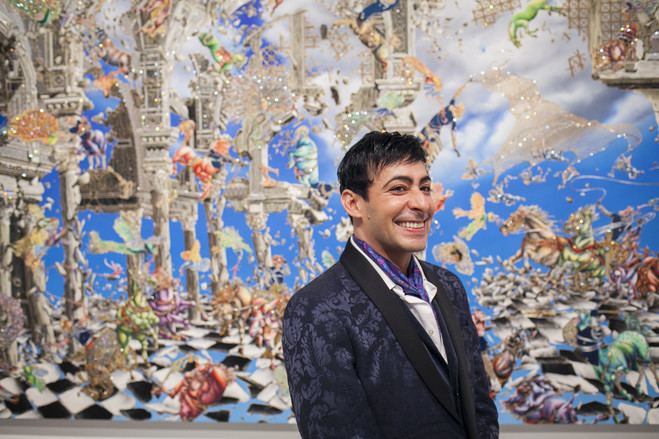 | ||
Raqib shaw new sculptures and paintings paris marais 2015
Raqib Shaw (born 1974) is an Indian-born, London-based artist who shot to fame in the international art world at the age of 33 . He is known for his opulent and intricately detailed paintings of imagined paradises, inlaid with vibrantly coloured jewels and enamel. His paintings and sculptures evoke the work of Old Masters such as Holbein and Bosch, whilst drawing on multifarious sources, from mythology and religion to poetry, literature, art history, textiles and decorative arts from both eastern and western traditions, all infused with the artist's imagination.
Contents
- Raqib shaw new sculptures and paintings paris marais 2015
- Raqib shaw at galerie rudolfinum prague
- Early life
- Artistic practice
- Garden of Earthly Delights 20022006
- Holbein 2007
- Adam 2008
- Absence Of God 20072009
- Narcissus 2011
- Of Beasts and Super Beasts 2012
- After George Stubbs Cheetah and Stag with Two Indians 2013
- Paradise Lost 20012013
- Solo exhibitions
- Group exhibitions
- Collections
- References

Raqib shaw at galerie rudolfinum prague
Early life
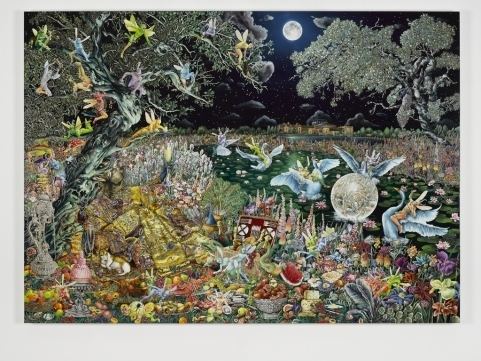
Raqib Shaw was born in Calcutta on 4 February 1974, but spent his formative years in Kashmir where his family worked as merchants.
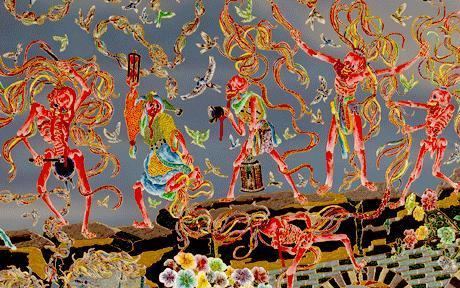
In 1989 political unrest began to grow in Kashmir, eventually driving the Shaw family to relocate to New Delhi in 1992. From 1992–1998 Shaw worked for his maternal uncle in the family business, an activity that ranged from interior design, architecture, to selling jewellery, antiques, carpets and fabrics. This opportunity brought him into contact with the many beautiful things that were being made in India.
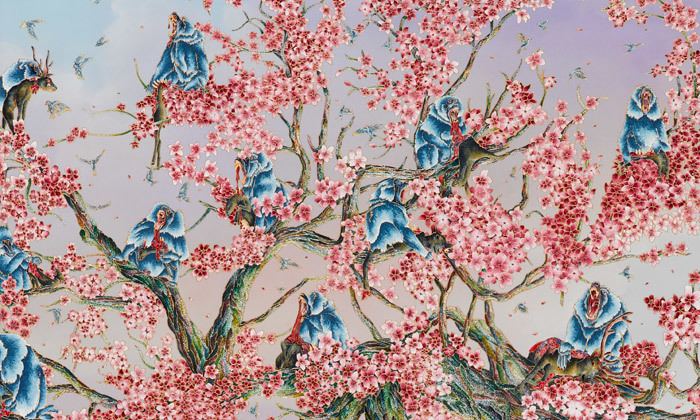
Family business brought Shaw to London in 1993, where he was able to see the paintings at the National Gallery for the first time. This encounter convinced him to spend the rest of his life in England as a practising artist.
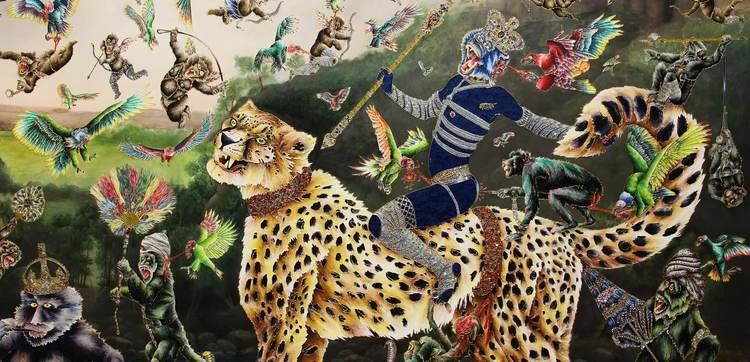
In 1998, Shaw moved to London where he studied for both his BA and MA at Central Saint Martins School of Art.
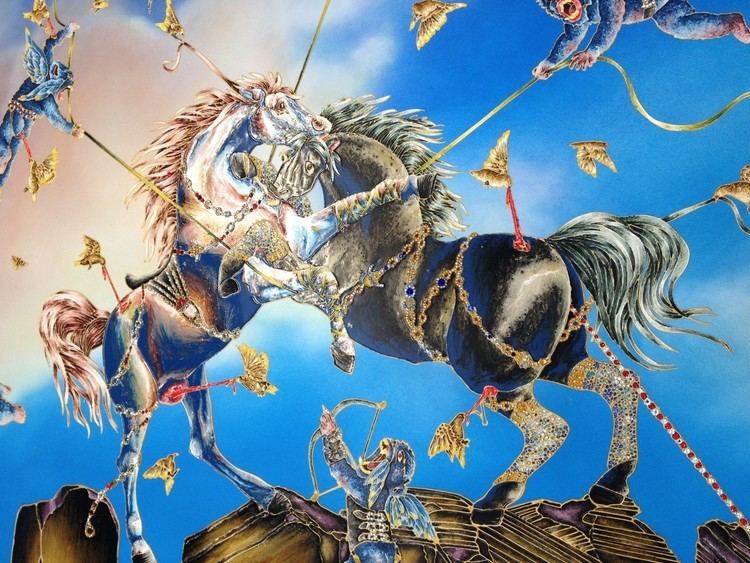
Though Shaw initially struggled with painting, his early experiments with a number of materials, namely enamel, household and car paint, bought from a local branch of Leyland, were to set the foundation for his technique of manipulating pools of industrial paint with a porcupine quill.
Artistic practice
Shaw's paintings suggest a fantastical world full of intricate detail, rich colour and jewel-like surfaces, all masking a collection of intensely violent and sexual images. Fused with an eco-system of vibrantly painted flora and fauna, half human/half animal creatures, with screaming mouths and engorged or bleeding eyes are characters in a dizzying scene of erotic hedonism, both explosive and gruesome in its debauchery.
Shaw says these fantastical worlds are laden with satire and irony, and can be read 'as a commentary on my own experience of living in this society, and of being alive'.
A typical painting consists of many stages. Shaw starts with small drawings on paper, featuring characters, flora and fauna. These are then transferred to acetate as individual elements. Shaw begins the composition of the painting by projecting these drawings onto the panel, starting from the centre and working outwards. Once the composition has been drawn out in pen, the panel is taken down from the wall and laid flat. Stained-glass liner is then applied, following the contours of the pen, to create tiny cofferdams. Using small plastic tubes with fine nozzles, paint is then poured into these dams and manipulated by a porcupine quill to suggest form. Glitter is added to specific parts providing extra ornamentation. Lastly, crystals are glued to highlight other areas.
Garden of Earthly Delights (2002–2006)
The inspiration for Shaw's first major exhibition was Hieronymus Bosch's Garden of Earthly Delights (1480–90). In a fantastical, hedonistic, phantasmagoria, populated by creatures, part aquatic/part animal/part human, Shaw describes an erotic underwater world clenched in perpetual orgasm.
Holbein (2007)
In part a response to the Holbein in England exhibition held in 2006–2007 at Tate Britain, Shaw reinterprets some of German artist Hans Holbein the Younger's (ca.1497–1543) English sitters. Creatures both natural and fantastic in medieval dress, romp amid architectural settings based on Holbein's designs for jewellery, stained glass, and book illustrations.
Adam (2008)
A bird-headed man is engaged in an erotic battle with a giant blue lobster. With limbs frozen in a spasm of pain or ecstasy, bulbous toads swim in the slime contained in the bird-man's open beak. This coupling of love and death reference the German romantic idea of Liebestod, literally 'love death'.
Absence Of God (2007–2009)
Inspired by the Italian artist Giovanni Battista Piranesi, Shaw's anthropomorphic creatures are framed within architectural renderings that are falling to ruin. Winged warriors simultaneously perform acts of bondage, flagellation and ritual disembowelment, while screaming hominid faces explode mid-air and regal monkeys survey, from under parasols, a mutant striving to catch flocks of glittering butterflies with a broken net.
Narcissus (2011)
A bestial coupling of a swan and a bat-headed human, Narcissus preserves post-Romantic art and literatures representation of the solitary, contemplative artist or poet, whilst referencing the classical myth of Leda seduced by Zeus disguised as a swan. It also alludes to the theme of Prometheus, who was bound to a rock, and had his liver pecked at each day by an eagle, an exemplar of the heroically suffering artist.
Of Beasts and Super-Beasts (2012)
Inspired by the satirical short stories of Saki, from which the exhibition title was borrowed, lascivious and vengeful monkeys, enthusiastically indulge in games of S&M in boudoirs sumptuously furnished in Napoleonic Imperial Paris style. Shaw's accompanying bestiary, Whimsy Beasties, is a phantasmagoria of strange inventions. The exercise, akin to the Surrealist game of the exquisite corpse, entails splicing together familiar animals to create bizarre hybrids.
After George Stubbs 'Cheetah and Stag with Two Indians' (2013)
For Manchester Art Gallery, Shaw re-activates George Stubb's Cheetah and Stag with Two Indians (1765), as a site of personal fantasy. Preserving the exact dimensions of the original, Shaw's painting is a faithful mirroring. A leopard-headed man wearing Ludwig of Bavaria's crown and wielding Queen Victoria's sceptre rides the majestic cheetah like a regal huntsman, while cherubic monkeys torment the deer with parasols and nets inlaid with precious stones.
Paradise Lost (2001–2013)
An homage to John Milton's epic poem, Paradise Lost is a visionary ode to the artist's own childhood memories and imaginary paradise over three chapters. In the first chapter, lone or contemplative characters attempt impossible feats. One waits attentively for moonbeams to drop into an ornate chalice, while another swings from the trees randomly catching the falling blossoms. In the second chapter, beastly anthropomorphic figures are depicted amidst fantastical worlds of idyllic skies and classical ruins.
